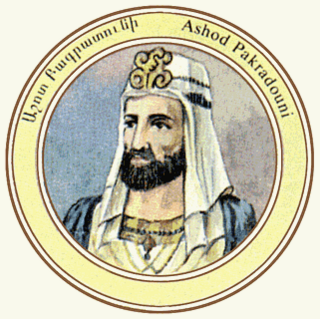This is a list of notable Armenians.
Smbat I was the second king of the medieval Kingdom of Armenia of the Bagratuni dynasty, and son of Ashot I. He is the father of Ashot II and Abas I.

Ashot I was an Armenian king who oversaw the beginning of Armenia's second golden age. He was the son of Smbat VIII the Confessor and was a member of the Bagratuni dynasty.
Gagik II was the last Armenian king of the Bagratuni dynasty. Known as Gagik II King of Ani he was enthroned as Gagik II and ruled for a brief period from 1042 to 1045 before the Bagratid dynasty rule collapsed in Armenia.

Gagik I was the king of Armenia who reigned between 989 and 1020, under whom Bagratid Armenia reached its height, and "enjoyed the accustomed experience of unbroken peace and prosperity."

Smbat II reigned as King of Armenia from 977 to 989. He was of the Bagratuni line of kings, and the son of Ashot III, whom he succeeded.

Ani is a ruined medieval Armenian city now situated in Turkey's province of Kars, next to the closed border with Armenia.

Abu'l-Aswar or Abu'l-Asvar Shavur ibn Fadl ibn Muhammad ibn Shaddad was a member of the Shaddadid dynasty. Between 1049 and 1067 he was the eighth Shaddadid ruler of Arran from Ganja. Prior to that, he ruled the city of Dvin from 1022 as an autonomous lord. A capable warrior, and a wise and cunning ruler, Abu'l-Aswar was engaged in several conflicts with most of his neighbours. During his rule over Dvin, he was mostly involved in the affairs of the Armenian principalities. He collaborated with the Byzantine Empire in its conquest of the last remnants of Bagratid Armenia in 1045, but when the Byzantines later turned on him, he survived three successive offensives that sought to take Ganja. In 1049, a revolt in Ganja overthrew his infant great-great-nephew, Anushirvan. The rebels invited him to take up the family's emirate, and he moved from Dvin to Ganja. Under his rule, the Shaddadid dynasty reached its zenith. He undertook successful campaigns into Georgia and Shirvan, although the limits of Shaddadid power were exposed by his failure to take over the Emirate of Tiflis and by devastating raids by the Alans. At the same time, his reign witnessed the rapid rise of the Seljuk Empire and the extension of its control over the Transcaucasian principalities. Abu'l-Aswar became a Seljuk vassal in 1054/5. Although he gained control over the former Armenian capital of Ani through Seljuk patronage in 1065, this association also paved the way for the dynasty's decline after his death in November 1067.
Smbat, Sambat, Smpad or Sempad may refer to:

Bagratid Armenia was an independent Armenian state established by Ashot I Bagratuni of the Bagratuni dynasty in the early 880s following nearly two centuries of foreign domination of Greater Armenia under Arab Umayyad and Abbasid rule. With each of the two contemporary powers in the region—the Abbasids and Byzantines—too preoccupied to concentrate their forces in subjugating the region, and with the dissipation of several of the Armenian nakharar noble families, Ashot succeeded in asserting himself as the leading figure of a movement to dislodge the Arabs from Armenia.

Ashot III was a king of Armenia, ruling the medieval kingdom of Armenia from 952/53–77. Known as Ashot III the Merciful and acknowledged by foreign rulers as the Shahanshah of Mets Hayk', he moved his royal seat of residence to Ani and oversaw its development and of the kingdom as a whole. Armenia reached the height of its golden era during his reign and that of his sons and successors, Smbat II (977–89) and Gagik I (990–1020).
Ashot IV, surnamed Kaj, i.e. "the Brave, the Valiant", was the younger son of King Gagik I of Armenia.

Hovhannes-Smbat III was King of Ani (1020–1040). He succeeded his father Gagik I of Ani (989–1020) being the king's elder son and legal heir to the throne.

The Kingdom of Vaspurakan was a medieval Armenian kingdom centered on Lake Van, located in what is now eastern Turkey and northwestern Iran. It was named after Vaspurakan, a province of historic Greater Armenia. Ruled by the Artsruni dynasty, it competed and cooperated with the Bagratuni-ruled Kingdom of Armenia for a little over a century until its last king ceded the kingdom to the Byzantine Empire in 1021.

The Bagratuni or Bagratid dynasty was an Armenian royal dynasty which ruled the medieval Kingdom of Armenia from c. 885 until 1045. Originating as vassals of the Kingdom of Armenia of antiquity, they rose to become the most prominent Armenian noble family during the period of Arab rule in Armenia, eventually establishing their own independent kingdom. Their domain included regions of Armenia such as Shirak, Bagrevand, Kogovit, Syunik, Lori, Vaspurakan, Vanand and Taron. Many historians, such as Cyril Toumanoff, Nicholas Adontz and Ronald Suny, consider them to be the progenitors of the Georgian royal Bagrationi dynasty.
The Bagratuni family tree describes the heritage of the Bagratuni family in Armenia. Bagratuni lineage also lays claim on Georgian Bagrationi dynasty.

The Kiurikian or Kiurikid dynasty was a medieval Armenian royal dynasty which ruled the kingdoms of Tashir-Dzoraget (978-1118) and Kakheti-Hereti (1029/1038-1105). They originated as a junior branch and vassals of the Bagratid dynasty, but outlived the main branch of the dynasty after the fall of the Bagratid Kingdom of Armenia. They became vassals of the Seljuk Turks in the second half of the 1060s. After the fall of the Kingdom of Tashir-Dzoraget to the Seljuks in the early 12th century, members of the dynasty continued to rule from their fortresses of Tavush, Matsnaberd and Nor Berd until the 13th century.
This page is based on this
Wikipedia article Text is available under the
CC BY-SA 4.0 license; additional terms may apply.
Images, videos and audio are available under their respective licenses.










